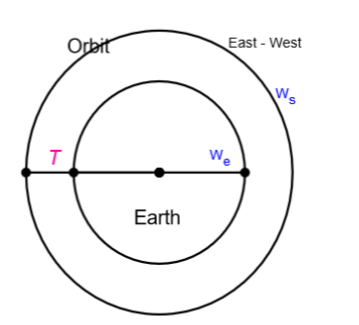
A satellite revolves in the geostationary orbit but in a direction east to west. The time interval between its successive passings about a point on the equator is:
A. 48hrs
B. 24hrs
C. 12hrs
C. Never
Answer
576.6k+ views
Hint: To solve this question we need to know that, when a satellite revolves in earth’s geostationary orbit, then the angular velocity of the satellite is the same as the angular velocity of earth. The relative angular velocity will be the sum of angular velocity of earth and angular velocity of the satellite.
And for a geostationary satellite, its time period (time taken to complete one rotation) is 24hrs.
Formula used:
Time period,
$T=\dfrac{2\pi }{\omega }$ .
Complete step-by-step answer:
In the question it is said that there is a satellite revolving in the geostationary orbit from east to west. We have to find the time interval between its successive passings about a point on the equator.

Consider earth as shown in the figure. The satellite is moving in an east west direction.
We know that earth has rotation. Therefore, let ${{\omega }_{e}}$ be the angular velocity of earth.
And let ${{\omega }_{s}}$ be the angular velocity of the satellite.
Let assume ‘T’ to be the time period between successive passings about the equator.
We know that, when a satellite is moving in the geostationary orbit of earth, its angular velocity is the same as that of earth’s angular velocity.
So we can write,
${{\omega }_{e}}={{\omega }_{s}}$
We have to find the time period of successive passing.
For that we have the equation of time period
$T=\dfrac{2\pi }{\omega }$
Here $\omega $ is relative angular velocity, which is equal to sum of angular velocities of earth and the satellite.
${{\omega }_{r}}={{\omega }_{e}}+{{\omega }_{s}}$
Therefore we rewrite T as
$\begin{align}
& T=\dfrac{2\pi }{{{\omega }_{e}}+{{\omega }_{s}}} \\
& T=\dfrac{2\pi }{2{{\omega }_{s}}} \\
& T=\dfrac{1}{2}\left( \dfrac{2\pi }{{{\omega }_{s}}} \right) \\
\end{align}$
We know that,$\dfrac{2\pi }{{{\omega }_{s}}}$ is the time period of a geostationary satellite.
For geostationary satellite, time period T = 24hrs
Hence we can substitute this in the equation.
$\begin{align}
& T=\dfrac{1}{2}\times 24 \\
& T=12hrs \\
\end{align}$
Therefore the time interval between a geostationary satellite's successive passing about the equator is 12hrs.
Hence the correct answer is option C.
Note: A geostationary satellite is a satellite that orbits earth. It is placed directly above the earth’s equator. These satellites are used to provide visible and infrared images of earth’s surface. Most common communication satellites and broadcast satellites are orbiting in the geostationary orbit.
And for a geostationary satellite, its time period (time taken to complete one rotation) is 24hrs.
Formula used:
Time period,
$T=\dfrac{2\pi }{\omega }$ .
Complete step-by-step answer:
In the question it is said that there is a satellite revolving in the geostationary orbit from east to west. We have to find the time interval between its successive passings about a point on the equator.

Consider earth as shown in the figure. The satellite is moving in an east west direction.
We know that earth has rotation. Therefore, let ${{\omega }_{e}}$ be the angular velocity of earth.
And let ${{\omega }_{s}}$ be the angular velocity of the satellite.
Let assume ‘T’ to be the time period between successive passings about the equator.
We know that, when a satellite is moving in the geostationary orbit of earth, its angular velocity is the same as that of earth’s angular velocity.
So we can write,
${{\omega }_{e}}={{\omega }_{s}}$
We have to find the time period of successive passing.
For that we have the equation of time period
$T=\dfrac{2\pi }{\omega }$
Here $\omega $ is relative angular velocity, which is equal to sum of angular velocities of earth and the satellite.
${{\omega }_{r}}={{\omega }_{e}}+{{\omega }_{s}}$
Therefore we rewrite T as
$\begin{align}
& T=\dfrac{2\pi }{{{\omega }_{e}}+{{\omega }_{s}}} \\
& T=\dfrac{2\pi }{2{{\omega }_{s}}} \\
& T=\dfrac{1}{2}\left( \dfrac{2\pi }{{{\omega }_{s}}} \right) \\
\end{align}$
We know that,$\dfrac{2\pi }{{{\omega }_{s}}}$ is the time period of a geostationary satellite.
For geostationary satellite, time period T = 24hrs
Hence we can substitute this in the equation.
$\begin{align}
& T=\dfrac{1}{2}\times 24 \\
& T=12hrs \\
\end{align}$
Therefore the time interval between a geostationary satellite's successive passing about the equator is 12hrs.
Hence the correct answer is option C.
Note: A geostationary satellite is a satellite that orbits earth. It is placed directly above the earth’s equator. These satellites are used to provide visible and infrared images of earth’s surface. Most common communication satellites and broadcast satellites are orbiting in the geostationary orbit.
Recently Updated Pages
Why is there a time difference of about 5 hours between class 10 social science CBSE

In cricket, what is a "pink ball" primarily used for?

In cricket, what is the "new ball" phase?

In cricket, what is a "death over"?

What is the "Powerplay" in T20 cricket?

In cricket, what is a "super over"?

Trending doubts
What are the major means of transport Explain each class 12 social science CBSE

Which are the Top 10 Largest Countries of the World?

Draw a labelled sketch of the human eye class 12 physics CBSE

How much time does it take to bleed after eating p class 12 biology CBSE

Explain sex determination in humans with line diag class 12 biology CBSE

Explain sex determination in humans with the help of class 12 biology CBSE




